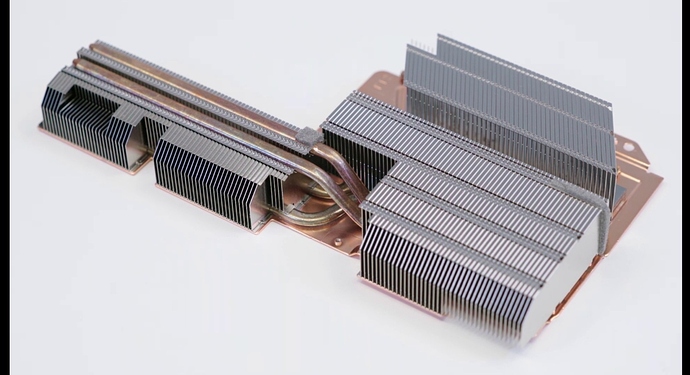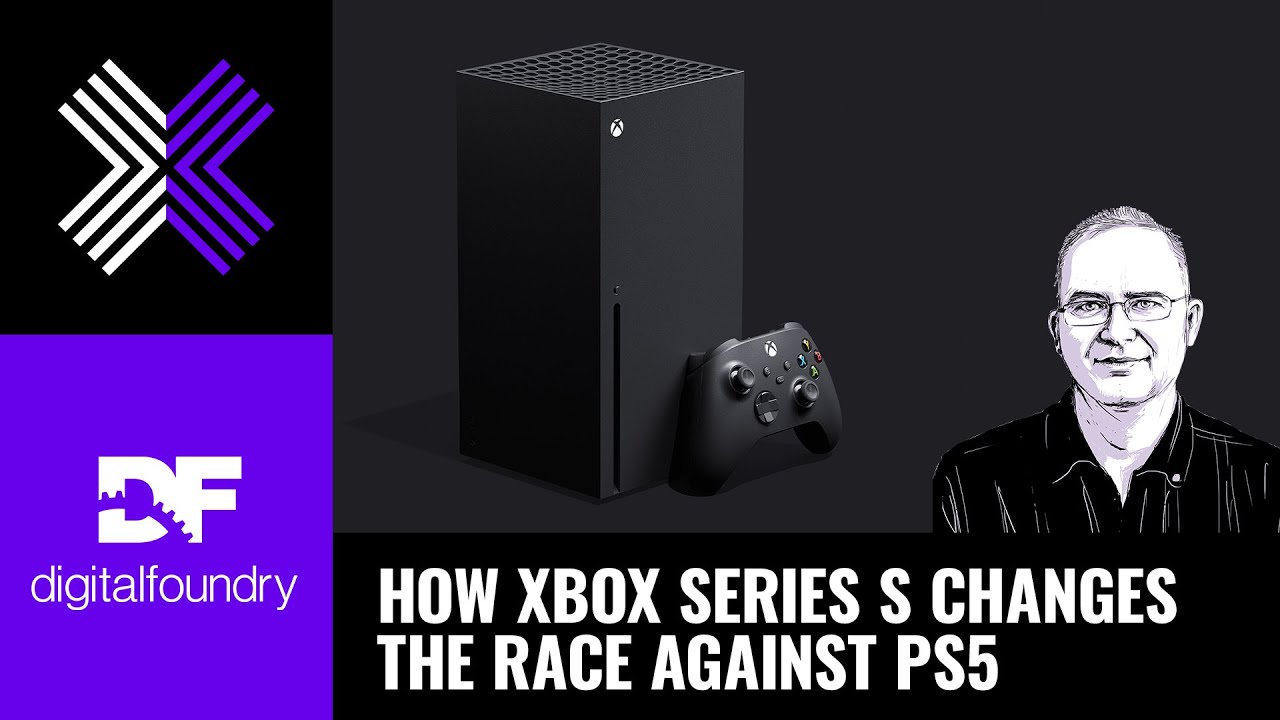Wow, what a super interesting video! I would assume that Sony did a ton of testing to ensure their special cooling solution doesn’t demolish their new product from the inside-out, but I guess you never know. Doesn’t matter to me personally since I’ll be waiting for a revision like you in all likelihood. And thank you to @Knottian for sharing their engineering expertise.
Copper isn’t effected as per the video!
Yeah I know but we’ll have to see for the other metallic parts and also the temperatures too in such a limited area. Hope we’ll see results soon. And who knows where the liquid metal could go if it leaks.
This is the PS5 Heatsink. I really hope their solution is solid as hell. It doesn’t inspire me confidence TBH.
I think the risk of drying up might be bigger than leaking based on what they have presented. But I could totally be wrong about that. It really remains to be seen. We need real world results after release.
Without knowing the heat capacity of the heatsink there is no way to know how much heat it is dissipating. Maybe someone could calculate theoretical output of the APU with the known contact area of the die but without knowing the fan speed and dimensions of the ducting, pitch of the fan veins, dimensions of the exhaust, dimensions of the total openings in the heatsink, etc you can’t do the fluid calculations to find the delta Q of the airflow either…
Would need all the specs I mentioned and more for people to come up with the theoretical heat transfer capability of the systems.
I’m not confident at all in Sony cooling solution.
That person who is supposedly vetted as a dev that has access to both nextgen machines, that doofus was saying that series s got cancelled. Again, being a genius is not required to understand whats going on over there.
The PS5 is very well engineered in my eyes, and what I mean by that is that they have really, really spent alot of time and money on the cooling system. Clocking a GPU that high in a console is a major risk, and doing so has put Sony in a situation to make sure that big old girl doesn’t overheat. Sony is one of the world’s best consumer electronics manufacturers, so I have faith the PS5 should be far quieter and cooler than the PS4 pro.
I’m still miffed about Sony staying with a 36CU GPU for the PS5. I honestly think they were going to release a year earlier, but didn’t and by that time the decision to stay with 36CUs, most likely to help with BC, was a year late and a few Cu’s short. No way Sony goes with variable clocks if they have the option not to. They got caught out by MS, and chased clocks to pull back some of the shortfall in performance.
I think the PS5 is lacking VRS, ML and some other features the XSX has, but how much of a difference that makes I’m not sure. I also think there will be a bigger learning curve on the XSX than the PS5, so the gap between the two won’t manifest until later.
Playstation 5 soldered 825 GB SSD puts a hard limit on the lifespan of each retail unit
"What will happen when the internal SSD inevitably dies? We’re not so sure. Whereas the primary drives in the PS3 and PS4 could all be easily replaced, the fixed SSD in the PS5 could be an issue far into the lifespan of the system."
I agree with some of your post for a console meant to have released in 2019, but I think those full-fat RDNA2 features (as well as the Microsoft-proprietary software solutions - XVA, for example) will have a pretty dramatic effect after the first year or two. You forget that while the XDK is a drastic departure (due to some new design efficiencies), it’s now also identical for developers to develop in PC environments as it is for the Xbox Series S/X, there’s DX12U, and RDNA 2 is about to launch next month to the PC market, so any “difficulty” in developing for the Xbox Series X is going to be fleeting. I put difficulty in quotes because it’s the fact that there are so many new design capabilities for PC and Xbox, and not that it’s “difficult” to take advantage of the base hardware advantages over the PS5 (additional CUs, faster CPU clocks, faster memory bandwidth, etc.).
Edit: Also, remember that Nvidia is going to be using XVA, and plenty of other Microsoft and RDNA2 features will be used widespread in the PC space as well, so that same design language gives the Xbox a development advantage once those additions become standard fare.
I don’t think this will be a big problem. Flash memory does degrade over time, but you would have to be deleting and installing games all day everyday to wear that drive out in a 5-7 year time span. I’m not an expert though, and I would like to know if they have a solution for this for “collectors” who like to keep working systems well past their due date.
The PS5 seems a very good design. However the xsx is more innovative because they did not let the traditional console set top box shape dictate what is possible for cooling and general hardware design.
PS5 is a good design and excellent piece of hardware!
But when XSX is put in front of it - PS5 is simply outclassed.
There is nothing bad in PS5 and most of the issues are just nit pickings. But XSX is ahead in almost every step.
PS5 design just makes XSX design look much better.
More raw performance and more compact 
Agreed, the read/write limit on these modules are probably much higher than your average consumer SSD - both have custom controllers as well; even if they didn’t, those limits have increased considerably since even just a few years ago. I imagine the SSD won’t be much of a concern, at least for the better part of a decade.
We seem to agree on most of it. I see alot of the XSXs advantage coming from software extensions such as VRS, Mesh Shaders, SFS and XVA. So let’s just take the SSD. Sony went with a hardware solution that delivers high performance. MS on the other hand went with software like SFS on the XVA. It’s going to take a bit more time to get the most out of SFS than straight IO speed.
However, once games get more complex, devs will really push into SFS, VRS, Mesh Shading etc and extract more performance, while with more demanding games the PS5 is going to struggle with variable clocks having to down clock more meaning less performance.
MS has truly out done Sony this generation. As a long suffering Xbox player, it has been so good to see what MS has done with rebuilding the brand after the OG Xbox One disaster. The console is a beast, they have built their first party I to the best in the business. My only worry now is I fear MS will keep Bethesda games on the PS5.
There is SFS hardware built into the GPU. The main difference is that the PS5 has io co processors, but the XSX uses part of the reserved ZEN2 core for io processing, its unknown how the xbox series deals with coherency and cache scrubbing. The PS5 and seriesX/S’s ssd and io setup is actually very similar, the main difference being is that the xbox uses a zen2 core to do io processing and the PS5 uses tiny processors specifically for the task. While I expect sonys approach is a bit better,most of the improvement will come from the raw speed advantage of the PS5s ssd, if the xbox series also had a 5.5gb/s SSD I think the performance would be practically the same, but with the PS5 still taking the edge.
However SFS will even things out a bit, I suspect the xbox solution will provide amazing results, the PS5 ssd/io system maybe overkill as ultimately what can be displayed on screen is limited by what the CPU can draw and what the GPU can render.
Its rather funny really, in all the speculation threads leading up to next gen, SSD and io was never really part of the conversation, the fancy UE4 and unity tech demos look next gen when using standard SSDs and windows io.
I think I recalled reading that IO processing is only taking a tenth of a zen 2 core on Series X.
To be fair, the internal SSD of Xbox Series is soldered to the motherboard too. So the same question can be asked there too.
In the article, the comparison is especially made with previous Sony consoles here.
Correct. Just like the PS5, the Xbox systems also have a custom decompression block to help with io speeds.
Should be noted that if ya use 4.8 GB/s on XSX as the compressed baseline and then compound that with SFS’s 2.5-fold multiplier, ya get a number larger than PS5’s I/O throughput of 8-9 GB/s. Both being ‘typical’ apparently. Also, SFS not only helps with effective I/O, but the same 2.5 factor also applies to the RAM utilization, which is pretty important as it can significantly reduce the need for streaming in the first place.
Regarding Digital Foundrys John liddlemans comments that we will be surprised by PS5 in a good way based on conversations he has had with devs, I think its nothing more than the state of PS5 dev environment, Cerny has said that making a ps5 game can essentially be like making a ps4 game but with vastly better specs, they dont have to learn or ultilise the new features the PS5 has, where as on the xbox side Microsoft have moved to the GDK which is a more general dev environment spanning across PC,X1 and seriesX/S, where the old dev platform (XDK) was more specific for xbox
Rich explains this at 39min in
However I seem to remember watching some xbox worker that a more specific dev environment for the xbox series is coming, but I cant remember where I saw this.

